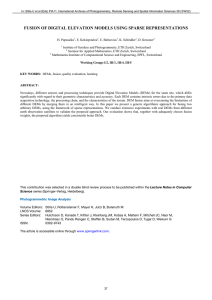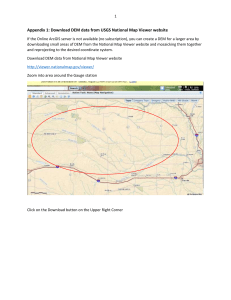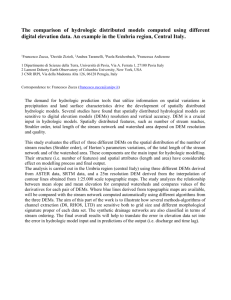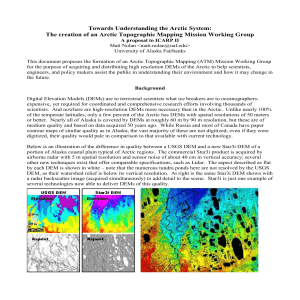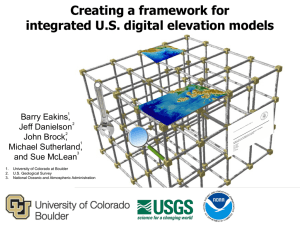MOSAICKING OF DIGITAL ELEVATION MODELS DERIVED BY SAR INTERFEROMETRY
advertisement
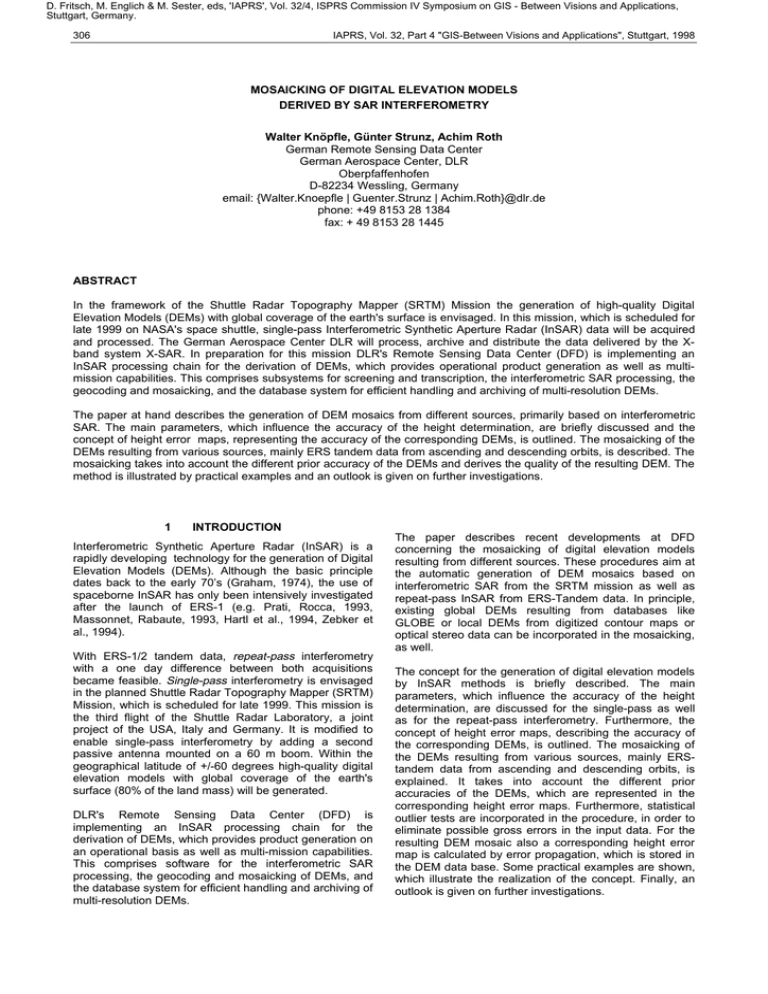
D. Fritsch, M. Englich & M. Sester, eds, 'IAPRS', Vol. 32/4, ISPRS Commission IV Symposium on GIS - Between Visions and Applications,
Stuttgart, Germany.
306
IAPRS, Vol. 32, Part 4 "GIS-Between Visions and Applications", Stuttgart, 1998
MOSAICKING OF DIGITAL ELEVATION MODELS
DERIVED BY SAR INTERFEROMETRY
Walter Knöpfle, Günter Strunz, Achim Roth
German Remote Sensing Data Center
German Aerospace Center, DLR
Oberpfaffenhofen
D-82234 Wessling, Germany
email: {Walter.Knoepfle | Guenter.Strunz | Achim.Roth}@dlr.de
phone: +49 8153 28 1384
fax: + 49 8153 28 1445
ABSTRACT
In the framework of the Shuttle Radar Topography Mapper (SRTM) Mission the generation of high-quality Digital
Elevation Models (DEMs) with global coverage of the earth's surface is envisaged. In this mission, which is scheduled for
late 1999 on NASA's space shuttle, single-pass Interferometric Synthetic Aperture Radar (InSAR) data will be acquired
and processed. The German Aerospace Center DLR will process, archive and distribute the data delivered by the Xband system X-SAR. In preparation for this mission DLR's Remote Sensing Data Center (DFD) is implementing an
InSAR processing chain for the derivation of DEMs, which provides operational product generation as well as multimission capabilities. This comprises subsystems for screening and transcription, the interferometric SAR processing, the
geocoding and mosaicking, and the database system for efficient handling and archiving of multi-resolution DEMs.
The paper at hand describes the generation of DEM mosaics from different sources, primarily based on interferometric
SAR. The main parameters, which influence the accuracy of the height determination, are briefly discussed and the
concept of height error maps, representing the accuracy of the corresponding DEMs, is outlined. The mosaicking of the
DEMs resulting from various sources, mainly ERS tandem data from ascending and descending orbits, is described. The
mosaicking takes into account the different prior accuracy of the DEMs and derives the quality of the resulting DEM. The
method is illustrated by practical examples and an outlook is given on further investigations.
1
INTRODUCTION
Interferometric Synthetic Aperture Radar (InSAR) is a
rapidly developing technology for the generation of Digital
Elevation Models (DEMs). Although the basic principle
dates back to the early 70’s (Graham, 1974), the use of
spaceborne InSAR has only been intensively investigated
after the launch of ERS-1 (e.g. Prati, Rocca, 1993,
Massonnet, Rabaute, 1993, Hartl et al., 1994, Zebker et
al., 1994).
With ERS-1/2 tandem data, repeat-pass interferometry
with a one day difference between both acquisitions
became feasible. Single-pass interferometry is envisaged
in the planned Shuttle Radar Topography Mapper (SRTM)
Mission, which is scheduled for late 1999. This mission is
the third flight of the Shuttle Radar Laboratory, a joint
project of the USA, Italy and Germany. It is modified to
enable single-pass interferometry by adding a second
passive antenna mounted on a 60 m boom. Within the
geographical latitude of +/-60 degrees high-quality digital
elevation models with global coverage of the earth's
surface (80% of the land mass) will be generated.
DLR's Remote Sensing Data Center (DFD) is
implementing an InSAR processing chain for the
derivation of DEMs, which provides product generation on
an operational basis as well as multi-mission capabilities.
This comprises software for the interferometric SAR
processing, the geocoding and mosaicking of DEMs, and
the database system for efficient handling and archiving of
multi-resolution DEMs.
The paper describes recent developments at DFD
concerning the mosaicking of digital elevation models
resulting from different sources. These procedures aim at
the automatic generation of DEM mosaics based on
interferometric SAR from the SRTM mission as well as
repeat-pass InSAR from ERS-Tandem data. In principle,
existing global DEMs resulting from databases like
GLOBE or local DEMs from digitized contour maps or
optical stereo data can be incorporated in the mosaicking,
as well.
The concept for the generation of digital elevation models
by InSAR methods is briefly described. The main
parameters, which influence the accuracy of the height
determination, are discussed for the single-pass as well
as for the repeat-pass interferometry. Furthermore, the
concept of height error maps, describing the accuracy of
the corresponding DEMs, is outlined. The mosaicking of
the DEMs resulting from various sources, mainly ERStandem data from ascending and descending orbits, is
explained. It takes into account the different prior
accuracies of the DEMs, which are represented in the
corresponding height error maps. Furthermore, statistical
outlier tests are incorporated in the procedure, in order to
eliminate possible gross errors in the input data. For the
resulting DEM mosaic also a corresponding height error
map is calculated by error propagation, which is stored in
the DEM data base. Some practical examples are shown,
which illustrate the realization of the concept. Finally, an
outlook is given on further investigations.
D. Fritsch, M. Englich & M. Sester, eds, 'IAPRS', Vol. 32/4, ISPRS Commission IV Symposium on GIS - Between Visions and Applications,
Stuttgart, Germany.
Knöpfle et al.
307
2
2.1
DEM GENERATION
difference between the measured height and the true
height normal to the reference ellipsoid.
Interferometric SAR
SAR interferometry exploits the phase of SAR signals to
measure differences to an accuracy of a fraction of the
wavelength. Phase differences of two complex-valued
SAR images of the same area, but from slightly different
orbits, are computed on a pixel-by-pixel basis (Bamler,
1997). A detailed description can be found e.g. in
Schwäbisch (1995). Figure 1 shows the principle of
repeat-pass and single-pass interferometry.
Height errors are given as absolute and relative values.
The absolute accuracy is the standard deviation of the
vertical error over all positions within a given area, the
relative accuracy is the standard deviation of the high
frequency component of the absolute error.
The performance requirements for SRTM aim at an
absolute (relative) height error of 16 m (6 m) for 90% of
the data, which is equivalent to a standard deviation of
about 10 m (4 m). For ERS-1/2 tandem data the goal is to
achieve an absolute height error of 30 m for 90% of the
data (standard deviation ~18 m) to meet the DTED2
standard.
3.2
Height error sources
The accuracy of an interferometrically generated DEM is
determined by 3 groups of error sources (Bamler, 1997):
- Phase noise: measurement accuracy of the phase
- Imaging geometry: accuracy of the orbit
- Atmospheric distortions: wave propagation conditions
Figure 1: Repeat- and single-pass interferometric SAR
2.2
Production chain
The entire processing chain comprises four subsystems,
the screening and transcription sytem, the SAR
processor, the generic system for interferometric SAR,
and the geocoding and mosaicking system. Within DFD’s
InSAR production system the interferometric processing
comprises spectral shift filtering, slope adaptive filtering,
coregistration, multilooking, coherence estimation, flat
earth phase removal, and several phase unwrapping
procedures (Eineder, Adam, 1997).
The geocoding and mosaicking system derives the DEM
from the unwrapped phase image. The absolute phase is
converted into height values and the slant range heights
are geocoded into the DEM. The product quality is
improved by the use of ground control points. This
adjustment requires two different kinds of control points,
i.e. for the correction of the timing parameters and for
phase offset determination. Individual DEMs can be
assembled to a DEM mosaic. Additionally, the system
also produces data sets, which are suitable for other
applications, as coherence maps, interferograms and
amplitude images (Roth et al., 1998).
3.2.1
Phase accuracy
The random phase error (phase noise) ±´ results in a
height error of
Vz )
Or sin T
V)
2kSB cos(T ] )
where ª is the wavelength, r is the slant range distance, §
is the look angle, ¥ is the baseline tilt angle and B is the
absolute baseline length as given in Figure 1 (k = 1 for
single-pass and k = 2 for repeat-pass interferometry).
Phase noise originates from different sources, mainly from
system noise (receiver and quantization noise) and
temporal scene decorrelation in case of repeat-pass
interferometry. The standard deviation of the phase can
be estimated as a function of coherence and number of
looks (Just, Bamler, 1994, Bamler, Hartl, 1998), where the
coherence is defined as the mutual correlation coefficient
between the two images. This dependency is illustrated
for 5 looks in Figure 2.
The final DEM product will be delivered to the user in tiles
of 15 arc minutes extension in both latitude and longitude.
A co-registered height error map will be provided as well,
which describes the product quality.
3
3.1
DEM ACCURACY
Definition
The accuracy of DEMs is defined by
horizontal errors. The horizontal error
difference between the measured and
ground; the vertical (height) error is
the vertical and
is given as the
true location on
defined as the
Figure 2: Standard deviation of the phase as a function of
coherence (number of looks: 5)
D. Fritsch, M. Englich & M. Sester, eds, 'IAPRS', Vol. 32/4, ISPRS Commission IV Symposium on GIS - Between Visions and Applications,
Stuttgart, Germany.
308
IAPRS, Vol. 32, Part 4 "GIS-Between Visions and Applications", Stuttgart, 1998
3.2.2
3.3
Imaging geometry
The errors resulting from the imaging geometry can be
mainly described by the following sources (Rodriguez,
Martin,1992):
-
Baseline length error ±%
Baseline tilt angle error ±¥
Slant range error ±r
Altitude error ±H
Position error ±x
The influence of these errors on the resulting height error
can be derived by differentiating the basic interferometric
equations. According to Rodriguez, Martin (1992) this
results in the following equations:
Vz B
r tan(T ] ) sin T
VB
B
Vz ]
r sin TV]
Vz r
cosTVr
Vz H
VH
Vz x
sin TVx
Atmospheric distortions
For repeat-pass interferometry several phenomena due to
different wave propagation conditions can appear.
Tropospheric water vapour may cause phase shifts in the
interferograms, which lead to cloud-like or ripple-like
phase structures. In practice, these are difficult to model,
therefore, they have to be eliminated e.g. by using several
interferograms for the DEM generation.
3.2.4
The actual error budgets depend on the mission
parameters. For SRTM and ERS tandem mission the
following parameter values are assumed:
Wave length:
Slant range:
Look angle:
Baseline length:
Baseline tilt angle:
Phase difference:
SRTM
3.1 cm
341 km
52 deg
62 m
45 deg
1580 deg
With errors (standard deviation) in
Slant range:
1.2 m
Baseline length:
2.4 mm
Baseline angle:
5.5”
Phase difference:
3 deg
ERS tandem
5.7 cm
847 km
23 deg
variable
variable
variable
9m
20 cm
variable
20-40 deg
In case of SRTM the following height errors can be
estimated based on the assumptions above. The main
influence factors, i.e. the height error due to random
phase error, the height error due to baseline length error,
the height error due to baseline tilt angle error, and a
height error due to an overall system error result in a total
height error of about 9 m (~ 15 m for 90 % accuracy).
Additionally, an overall system error including calibration
errors can be taken into account.
3.2.3
Error budget for SRTM and ERS tandem
In case of ERS tandem the configuration of ERS-1 and
ERS-2 is not fixed. Baseline lengths and tilt angles are
variable and have to be derived from the orbits. The ERS
orbits are only known with an accuracy of about +/-20 cm,
which is an order of magnitude worse than with SRTM,
where the baseline is directly observed. This requires an
additional control point measurement and adjustment.
Furthermore, the one day repeat pass configuration leads
to decorrelation and occasionally to atmospheric
distortions.
The height errors due to random phase errors for ERS
tandem are given in Figure 3 for two different baseline
lengths.
Resulting height error
The total height error is the root sum square of all
independent height error contributions:
Vz total
Vz ) Vz B Vz ] Vz r Vz H Vz x
2
2
2
2
2
2
Figure 3: Height error due to phase noise
(for baseline length of 100 m (upper line) and of 300 m
(lower line) and for baseline tilt angle of 45 deg)
Vz total
Vz phase Vz geometry
2
2
The height errors due to errors in baseline length are
given in Figure 4.
D. Fritsch, M. Englich & M. Sester, eds, 'IAPRS', Vol. 32/4, ISPRS Commission IV Symposium on GIS - Between Visions and Applications,
Stuttgart, Germany.
Knöpfle et al.
309
parameters, to minimize the horizontal location errors and
points with well defined heights for the adjustment of the
absolute phase, to minimize the vertical height errors.
This is achieved by a least square fit: a linear approach
proved to be sufficient for the timing parameters, whereas
for phase offset adjustment a two dimensional second
order approach is required. This is equivalent to an
improvement of the slave orbit and requires at least 6
phase control points. The standard deviation of the
residuals of the used phase control points with respect to
the corrected absolute phase can be used to define the
remaining height error after the adjustment. This height
error is usually smaller than the errors ±zgeometry in case of
ERS tandem.
Figure 4: Height error due to baseline length error of 20
cm (for baseline tilt angle of 45 deg and different baseline
lengths)
The height errors due to errors in baseline tilt angle are
given in Figure 5. This error depends on uncertainties of
orbit positions ±p and baseline length B according to:
V]
arctan(
To take into account the number of GCPs used, the
statistical error bound for the standard deviation is
calculated based on the µ2-function. It includes the
degrees of freedom in the least square fit with n control
points and u = 6 unknown parameters. This is illustrated in
Figure 6 for a height error of 20 m.
Vp
)
B
Figure 6: Upper and lower limit of standard deviation
(for standard deviation of 20 m)
Figure 5: Height error due to baseline tilt angle error
(for ±p equal to 20 cm and different baseline lengths)
Figures 4 and 5 show that for ERS tandem data
considerable height errors are to be expected. Therefore,
substantial improvements over the initial geometry are
necessary to meet the DTED2 height error requirements.
This improvement can be achieved by the use of ground
control points.
3.4
The upper limit of standard deviation ±zGCP is compared
to the calculated ±zgeometry. If the accuracy based on the
GCPs is better than ±zgeometry, which is in most cases true
for ERS tandem, then it is replaced by ±zGCP. If not, then
±zgeometry is used. The resulting total height error is then
calculated according to:
Vz total
Vz phase Vz geometry / GCP
2
2
Improvement by control points
Whereas the height errors ±zphase resulting from the phase
noise are of random nature, the height errors ±zgeometry are
due to the geometric configuration and its uncertainty.
This initial geometry can be improved by a proper set of
ground control points (GCPs). Then the errors ±zgeometry
can be partly improved by an error estimation based on
control points.
Precondition is a well defined set of control points
regularly distributed over the area of interest. Two types of
control points are to be distinguished: Points with well
defined location for the adjustment of the timing
3.5
Data border handling
Especially for the mosaicking of various DEMs (section 4)
an additional border handling is included in the calculation
of the accuracy. Towards the border of the DEM data
there is an increasing uncertainty of the height values.
This is mainly due to the processing with several filtering
and resampling steps which negatively effects the data
borders.
An additional feathering is recommended to take this into
account. A moving window of 101 square pixels is used
for weighting. The local weight is given by:
D. Fritsch, M. Englich & M. Sester, eds, 'IAPRS', Vol. 32/4, ISPRS Commission IV Symposium on GIS - Between Visions and Applications,
Stuttgart, Germany.
310
p
IAPRS, Vol. 32, Part 4 "GIS-Between Visions and Applications", Stuttgart, 1998
§
s2 s2 ·
¨¨ (n ) /( ) ¸¸
2
2 ¹
©
2
where p is the local weight, n is the coverage with valid
height data and s is the size of the moving window. The
weight p is equal to 1 inside the data and decreases to
zero at the edges. The corresponding height error is then
given by:
orientation parameters of the stereo images. The number
and the definition of the orientation parameters depends
on the mathematical model used for the line scanner
imagery. The main influence parameters are the baseline
length and height of the sensor platforms.
The resulting height error can be mainly described by:
Vz total
Vz Border
Vz poin t ( local ) Vz geometry ( global )
2
2
1 p
3.7
which is shown in Figure 7.
Height error map
The height error is calculated for every pixel location
within the DEM and the corresponding height error map is
created. It represents the height error for every pixel
within the data set and is used as input for the
mosaicking.
4
DEM MOSAICKING
The mosaicking procedure creates large area DEMs from
various input DEMs of the same coordinate system, along
with the co-registered corresponding height error maps.
Mosaicking of DEMs also includes compositing of DEM
data sets for the same area. This is done by averaging the
available height values within overlap areas. Proper
weighting of the individual input height values is essential
for this procedure.
Figure 7: Additional height error due to data border
handling
In case the border feathering is included, this results in a
total height error of:
Vz total
3.6
Vz phase Vz geometry / GCP Vz border
2
2
The resulting height value is calculated according to:
1
z
¦p
2
Height errors of DEMs from optical stereo data
As for the mosaicking, DEMs from various sources are
used, the height errors of DEMs derived from optical
stereo scanner data also have to be modeled. This is
briefly described in the following. Similar to InSAR derived
DEMs the error sources can be grouped into:
- Measurement noise: accuracy of point determination
- Imaging geometry: accuracy of exterior orientation
The measurement accuracy of each individual point can
be derived from the matching procedure. If e.g. least
squares matching is used, then the standard deviation of
point determination can be estimated (Ackermann, 1984).
This accuracy is mainly depending on the grey value
gradients and the degree of correspondence of the
homologous points in the matching procedure. An
additional factor is the location of the points in the two
images, which influences the geometric accuracy of the
object point determination.
The accuracy resulting from the imaging geometry can be
determined based on the inverse of the normal equation
matrix of the least squares estimation of the exterior
(¦i 1 z i pi );
n
n
pi
(
1 2
)
Vi
i
i 1
where n is the number of height values, zi are the input
height values and pi are the weighting factors as given by
the standard deviation ±L of the input height error maps.
The resulting height value is estimated according to the
least squares principle, which additionally provides the
accuracy of the resulting height as:
V
z
V
1
0
¦
pi
;
V
2
0
¦
2
vi pi
n 1
where ± is the estimated variance factor and vi are the
residuals.
The detection of gross errors in the input heights is also
included in the procedure. The outlier test investigates the
hypothesis
H 0 : max(abs (
vi
)) d t n u ,Z
Vv i
where vi and ±YL are the estimates for residuals and their
standard deviations and t is the Student function with the
degree of freedom (n-u) and the error probability ·.
D. Fritsch, M. Englich & M. Sester, eds, 'IAPRS', Vol. 32/4, ISPRS Commission IV Symposium on GIS - Between Visions and Applications,
Stuttgart, Germany.
Knöpfle et al.
311
The outlier test is being performed iteratively, and
identified faulty values are excluded from averaging. This
allows for a robust estimation of the resulting heights. The
quality of the resulting DEM is thus determined by error
propagation of the a priori accuracy as given by the
corresponding input height error maps.
5
5.1
20 m or cloud-like bubbles in DEM 4 (second row right).
Low coherence in the DEMs 1 (upper left) and 7 (lower
left) results in quite noisy height models, and missing
fringes due to bad coherence lead to erroneous flat hill
tops. The DEM 8 derived from the SPOT stereo pair
(lower right) shows less detailed structures as compared
to the InSAR DEMs.
PRACTICAL EXAMPLE
Test Data
An area south west of Hannover was selected as test site.
The area shows flat and hilly regions mainly covered with
grassland and forests. Seven ERS-1/2 tandem data pair
sets (two ascending and five descending orbit) were
processed. The relevant parameters describing the data
are listed in Table 1. Additionally a stereo pair from SPOT
XS was included in the investigations.
DEM
1
2
3
4
5
6
7
8
Orbits
20233/0649
22326/2653
23328/3655
24831/5158
24938/5265
24938/5265
25833/6160
50
Frame
2547
2547
2547
2547
1035
1053
2547
244
Quad.
1
1
1
1
1
4
1
Acquisition Date
04/05-06-95
22/23-10-95
30/31-12-95
14/15-04-96
21/22-04-96
21/22-04-96
23/24-06-96
01/02-04-90
Table 1: Data sets used in the test site
Table 2 shows the values for baseline lengths and
baseline tilt angles as well as the number of ground
control points, which were measured in the data sets.
DEM
Baseline
length
Baseline
tilt angle
1
2
3
4
5
6
7
8
117 m
108 m
193 m
93 m
98 m
97 m
110 m
508 km
49 deg
0 deg
43 deg
44 deg
-2 deg
0 deg
48 deg
--
Number of
time control
points
47
42
38
44
18
48
42
--
Number of
phase contr.
Points
48
50
46
51
31
31
46
--
Table 2: Baseline parameters and number of measured
control points
The standard deviations of the time control points resulted
in less than 30 m horizontal error. This is an important
precondition for the compositing of heights within the
overlap areas. The resulting standard deviations of phase
control points show height errors of 4 - 7 m. For the DEM
from the SPOT stereo pair a set of 12 control points was
measured resulting in a height standard deviation of 15 m.
5.2
DEM generation
In Figure 8 the input DEMs are shown as colour shaded
relief representations.
The DEMs created from ERS-1/2 tandem pair data show
very detailed topographic structures. However, small to
medium atmospheric disturbances or low coherence lead
to errors in the data. For instance, there are wave-like
structures in DEM 2 (upper right) of magnitude of up to
Figure 8: DEMs as result of the DEM generation
The accuracy of the individual eight DEMs was derived
based on the described concept. Figure 9 shows an
example of a height error map. The mean height error is
about 15 m. Values from 7 to 15 m for grassland (dark
values) and 12 to 22 m for forest regions (bright values)
are mainly due to the differences in coherence.
D. Fritsch, M. Englich & M. Sester, eds, 'IAPRS', Vol. 32/4, ISPRS Commission IV Symposium on GIS - Between Visions and Applications,
Stuttgart, Germany.
312
IAPRS, Vol. 32, Part 4 "GIS-Between Visions and Applications", Stuttgart, 1998
Figure 9: Height error map of DEM 2
In Table 3 an example is given, how the different
parameters contribute to the total height error for a
representative location within the data sets.
DEM
1
2
3
4
5
6
7
8
Local co- Std dev
herence of phase
±´
0.488
55 deg
0.570
47 deg
0.539
50 deg
0.625
42 deg
0.133
91 deg
0.531
51 deg
0.535
50 deg
---
Height
Error
]SKDVH
13.8 m
12.4 m
7.2 m
12.6 m
26.7 m
14.9 m
13.2 m
--
Height
Error
±]*&3
6.6 m
6.8 m
7.3 m
5.7 m
9.4 m
6.5 m
6.6 m
--
Figure 10: Mosaicking result from ERS-1/2 tandem data
and SPOT stereo data
Height
Error
±]WRWDO
15.3 m
14.1 m
10.3 m
13.8 m
28.3 m
16.3 m
14.8 m
18.9 m
Table 3: Example for derivation of the total height error for
a single location
5.3
Mosaicking
The mosaicking was done with the 8 input data sets
taking into account the corresponding height error maps
and including the outlier test. The result is shown in Figure
10.
Together with the mosaic, the resulting height error map
and a coverage map are derived, which shows the
number of used height values after the outlier test. For
some hilly areas the number of input heights is reduced
from initially 7-8 to 3-4 remaining values.
Figure 11: Reference model DHM M745 for the test site
5.4
Quality assessment of the mosaicking concept
In order to evaluate the quality of the mosaicking
procedure, a reference model is used. The DHM M745,
provided by the German military mapping agency
AmilGeo, is used for this purpose. Figure 11 shows this
reference model, which covers an area of about
100 * 120 km.
The differences between the individual eight DEMs and
the reference model are calculated in terms of root mean
square (rms) errors. They resulted in errors from 12 m to
36 m, which fit quite well to the theoretical values derived
by the concept of the height error maps.
For a detailed discussion a small part of the mosaic is
investigated (15 * 17 km), a hilly region completely
covered by forest, which is shown in Figure 12.
D. Fritsch, M. Englich & M. Sester, eds, 'IAPRS', Vol. 32/4, ISPRS Commission IV Symposium on GIS - Between Visions and Applications,
Stuttgart, Germany.
Knöpfle et al.
313
6
CONCLUSIONS
Recent developments at DFD concerning the mosaicking
of digital elevation models resulting from different sources
have been described. The results show, that the
mosaicking considerably improves the quality of the DEM
product. Further modifications of the algorithm will be
performed and tested. The aim is to establish an
operational system for the automatic generation of DEM
mosaics based on interferometric SAR from the SRTM
mission as well as repeat-pass InSAR from ERS-tandem
data and also from DEMs, which result from existing
databases, digitized contour maps or optical stereo data.
REFERENCES
Ackermann, F. (1984): Digital image correlation:
performance and potential application in photogrammetry.
Photogrammetric Record, 64(11), 429-439.
Bamler, R. (1997): Digital Terrain Models from Radar
Interferometry. In: Fritsch, D., Hobbie, D. (Eds.): Photogrammetric Week ’97, Wichmann, Heidelberg, 93-105.
Bamler, R., Hartl, P. (1998): Synthetic Aperture Radar
Interferometry. Review article submitted to Inverse
Problems.
Figure 12: Detail area of the DEM mosaic
Three different mosaicking approaches are applied:
M1) Simple averaging of heights
M2) Weighted averaging of heights
M3) Weighted averaging of heights including outlier test
and the resulting DEM mosaic as well as the input DEMs
are compared to the reference DHM M745. Table 4 shows
the results of this evaluation.
DEM /
Mosaicking
approach
RMS
errors
Height difference
Percentage within +/-
1
2
3
4
5
6
7
8
M1
M2
M3
55.1 m
19.6 m
15.8 m
14.6 m
16.5 m
15.2 m
48.8 m
23.2 m
14.5 m
10.9 m
10.7 m
8m
37%
57%
80%
46%
60%
43%
43%
40%
73%
79%
81%
16 m
53%
81%
90%
79%
82%
70%
66%
62%
85%
90%
95%
32 m
74%
93%
94%
97%
94%
98%
79%
84%
93%
98%
99%
Table 4: Evaluation results for the mosaicking approaches
In Table 4 the improvement by the mosaicking is visible.
The rms errors of the mosaics are, except of method M1,
considerably better than those of the individual input
DEMs. Comparing the different mosaicking approaches, it
can be seen, that M3 gives the best results.
Further improvements of the mosaicking procedure are
under discussion. Concerning the height error estimation
from phase control points, the simple global value will be
replaced by a two-dimensional error function resulting
from the least square fit. This will also take into account
the distribution of the points. Another modification is the
use of context-based instead of pixel-based averaging.
Eineder, M., Adam, N. (1997): A flexible system for the
generation of interferometric SAR products. Proceedings
IGARSS’97, Singapore.
Graham, L. C. (1974): Synthetic interferometer radar for
topographic mapping. Proceedings IEEE, 63(6), 763-768.
Hartl, P., Thiel, K.-H., Wu, X., (1994): Information
extraction from ERS-1 SAR data by means of InSAR and
D-InSAR techniques in antarctic research. Proceedings
2nd ERS-1 Symposium, Hamburg, 697-701.
Just, D., Bamler, R. (1994): Phase statistics of
interferograms with applications to synthetic aperture
radar. Applied Optics, 33(20), 4361-4368.
Massonnet, D., Rabaute, T. (1993): Radar interferometry:
limits and potential. IEEE Transactions on Geoscience
and Remote Sensing, 31(2), 455-464.
Prati, C., Rocca, F. (1993): Improving slant range
resolution with multiple SAR surveys. IEEE Transactions
on Aerospace and Electronic Systems, 29(1), 135-144.
Rodriguez, E., Martin, J.M. (1992): Theory and Design of
Interferometric Synthetic Aperture Radars. IEEE
Proceedings-F, 139(2), 147-159.
Roth, A., Knöpfle, W., Hubig, M., Adam, N. (1998):
Operational Interferometric SAR Products. Proceedings
IGARSS’98, Seattle.
Schwäbisch, M. (1995): Die SAR-Interferometrie zur
Erzeugung digitaler Geländemodelle. DLR-Forschungsbericht 95-25.
Zebker, H. A., Werner, C. L., Rosen, P. A., Hensley, S.
(1994): Accuracy of topographic maps derived from ERS1 interferometric radar. IEEE Transactions on Geoscience
and Remote Sensing, 32(4), 823-836.
